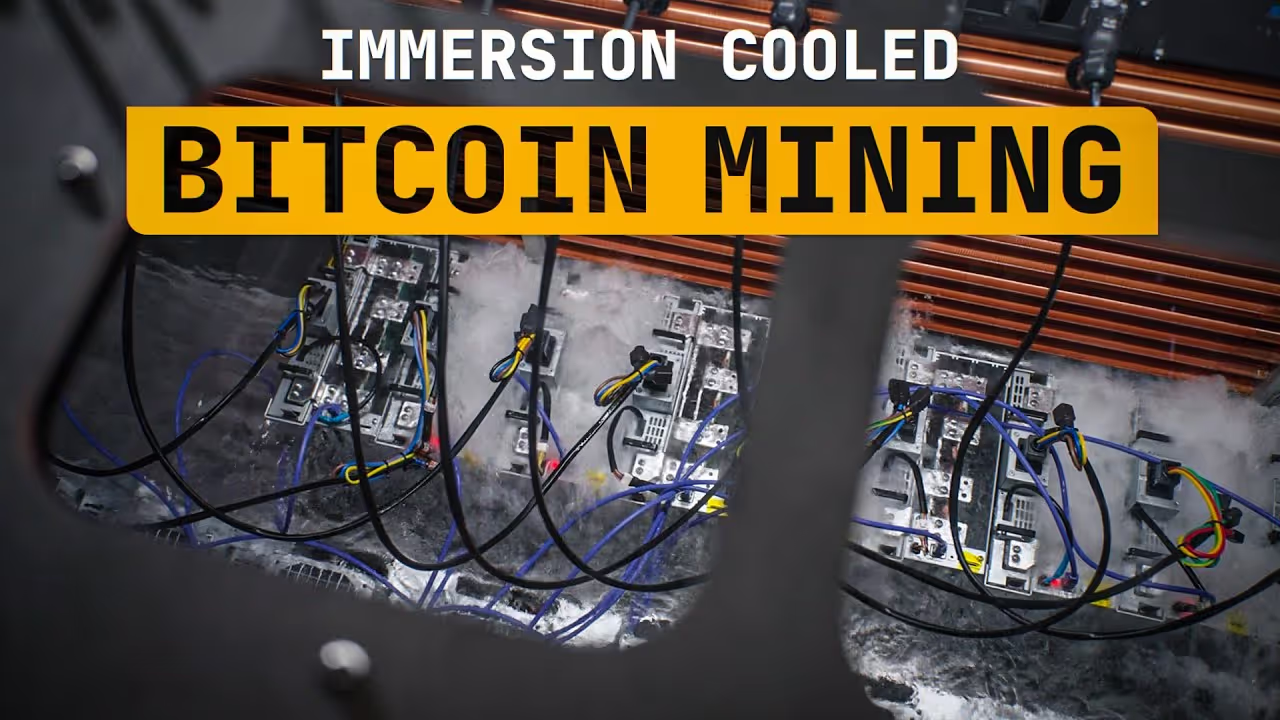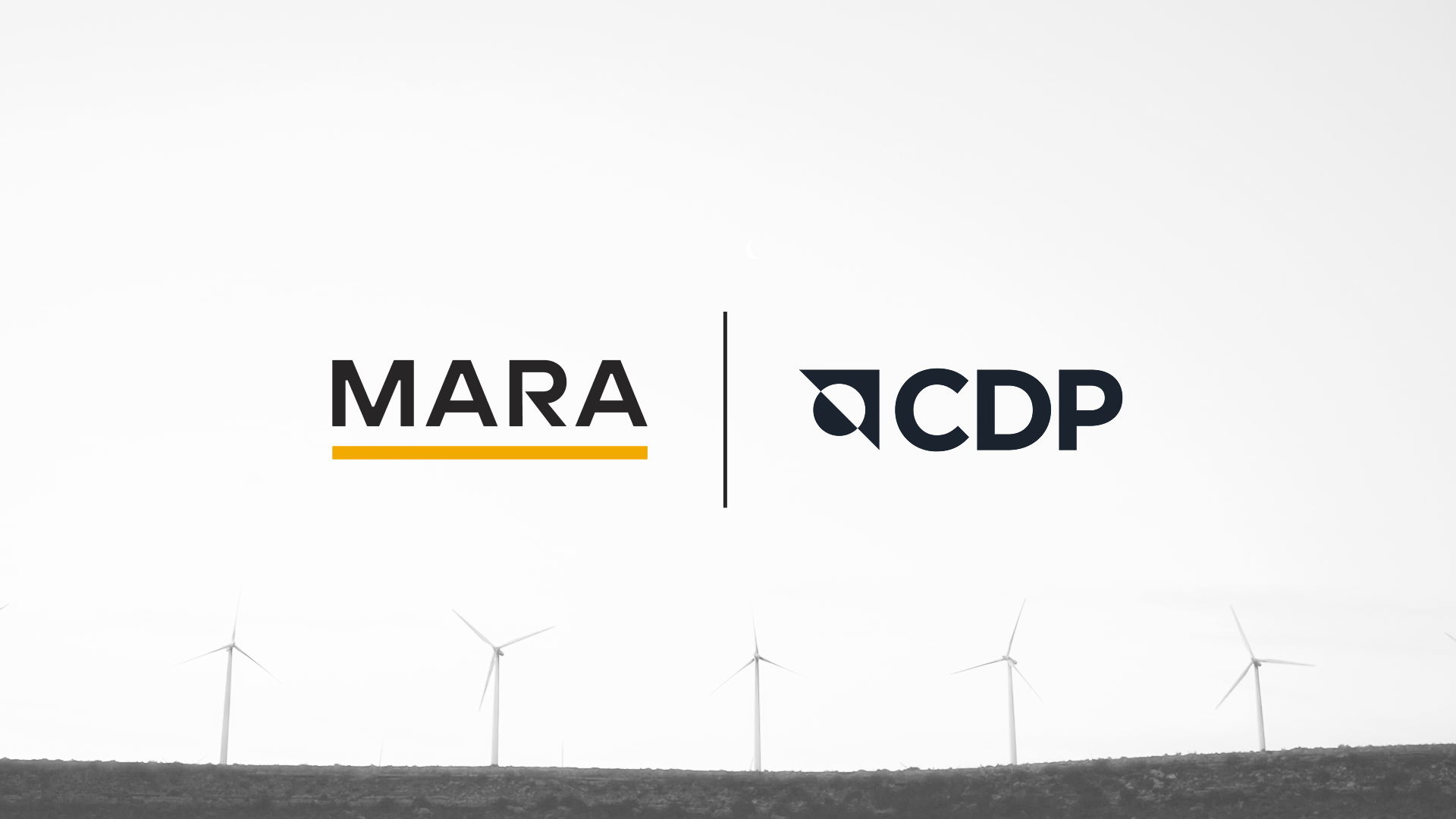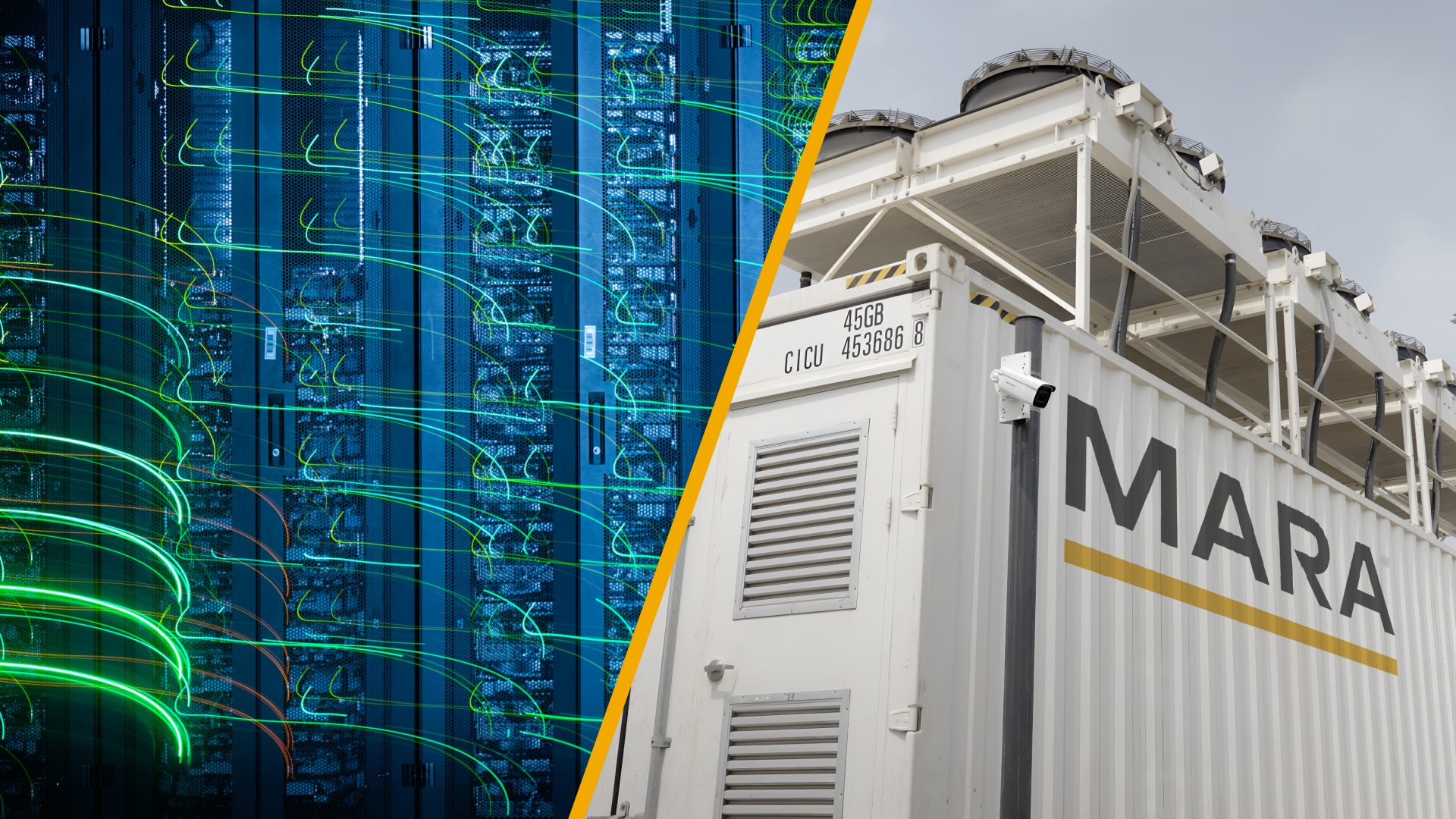Related video: Immersion-Cooled Bitcoin Mining
Learn about immersion, its benefits over air-cooled setups, and the different approaches to implementing it.
Learning Objectives:
- Understand the concept of immersion-cooled Bitcoin mining and how it differs from air-cooled mining
- Recognize the importance of effective heat management and the adverse effects of operating an overheated Bitcoin miner
- Learn about the benefits of immersion mining and the different approaches to implementing it
Disclaimer
This report is provided for general informational purposes only. The opinions expressed in the report may differ from those expressed by Marathon Digital Holdings ("MDH"), its officers, employees, directors or advisors or their affiliates. The information on this report does not constitute investment, legal, accounting or other advice or information by MDH or its officers, employees, directors or advisors or their affiliates. Information has been obtained from sources believed to be reliable, but MDH or its affiliates do not warrant its completeness or accuracy. Outlooks and past performance are not guarantees of future results. The information in the report may be changed without notice and is not guaranteed to be complete, correct or up-to-date, and may not reflect the most current developments.
What is Immersion-Cooled Bitcoin Mining?
Immersion-cooled Bitcoin mining, or simply “immersion,” is a method of submerging mining hardware into a pool of dielectric (nonconductive) fluid – typically with oils or synthetic liquids – to boost productivity, reduce noise, realize other benefits, and, most importantly, to dissipate the heat generated by the ASIC miners. This approach differs from the traditional air-cooled method, which uses fans to circulate the air around the miners in order to reduce their temperature.
Why is Cooling Important in Bitcoin Mining?
Bitcoin mining requires an immense amount of energy for the computation-intensive process of converting electricity into hashes to validate transactions and earn bitcoin rewards. This process expels a significant amount of heat as a byproduct, and it must be dissipated quickly. To address overheating, miners utilize two primary cooling methods: air cooling and immersion cooling.
For miners, effective heat management is one of the critical aspects of running an efficient and resilient operation because, if not adequately managed, excess heat can lead to increased electricity consumption and decreased efficiency – the hotter a miner runs, the more likely that something could go wrong.
The negative effects of operating an overheated miner:
- Reduced Hash Rate: Overheating can cause the miner’s hash rate to drop, reducing the overall mining output and decreasing the chances of winning new bitcoin.
- Increased Power Consumption: Excess heat can cause the miner to consume more power per terahash, increasing its overall operating costs to mine a bitcoin.
- Reduced Efficiency: When a miner is overheated, it consumes more energy while producing fewer hashes, meaning that the miner is “working” harder and less productively.
- Increased Wear and Tear: Overheating can lead to increased wear and tear on the components and electrical equipment, such as the power distribution units (PDUs), switchgear, and transformers, which can shorten their lifespan and increase the frequency of repairs or replacements.
- Damage to the Hardware: Overheating can cause permanent damage to the hardware, rendering it unusable and requiring replacement.
- Increased Noise: When a miner is overheated, it will attempt to cool itself down by increasing the speed of its fans, producing up to 90 decibels at maximum fan speeds.
- Reduced Profit Margins: Due to all the above reasons, a miner's profit margins can be greatly affected by overheating, increasing costs, and decreasing earnings.
Figure 1: Power Consumption Vs. Hash Board Temperature1

According to an experiment by BRAIINS, which kept the frequency (hash rate) of a miner constant, the temperature (Celsius) of the hash board inside a miner was positively correlated with its power draw (watts); the hotter an ASIC miner runs, the more electricity it consumes. Today, most operators rely on air-cooled setups to address overheating.
What is Air-Cooled Bitcoin Mining?
Air-cooled setups, as the name suggests, involve fans to regulate the temperature of the Bitcoin-hashing chips (ASICs) inside a miner and are the most commonly used technique for cooling Bitcoin miners today. Most miners on the market today come with preinstalled fans designed to move air in a push-pull fashion, drawing in cooler air around the periphery of the miner and distributing it over the heatsinks inside. Heatsinks are attached to the ASICs with thermal adhesive and are capable of absorbing and dispersing heat away from the hash board; their large surface area and thermal conductivity maximize heat dissipation. As the temperature of the miner fluctuates, temperature sensors help adjust the fan speed accordingly.
In addition to preinstalled fans, large-scale mining farms typically install more sophisticated ventilation and filtration systems, such as exhaust fans and air coolers, to manage not only the temperature but also the airflow, humidity, and dust to ensure a steady ambiance.
Figure 2: Diagram of an Air-Cooled Mining Facility

Figure 3: Diagram of Air-Cooled Mining Using Containers

How Does Immersion Cooling Work and What Benefits Does It Provide?
Immersion involves submerging miners into a tank filled with dielectric fluid. This method takes advantage of the higher thermal conductivity of liquids compared to air to dissipate the heat generated by the ASICs more efficiently. As such, immersion setups provide several advantages over air-cooled configurations.
The benefits of immersion mining:
- Higher Hash Rate: With improved cooling, mining hardware can operate at higher performance through overclocking to produce more hashes, leading to a higher chance of earning block rewards (i.e., bitcoin).
- Reduced Power Consumption: Immersion can help reduce the power consumption of miners, as the preinstalled fans and/or other parts from the miners can be removed.
- Increased Efficiency: Liquid coolant used in immersion allows for more efficient heat transfer since fluids have a higher thermal conductivity than air. This can reduce the overall cost of running the miners, excluding the additional expenses required by immersion.
- Reduced Wear and Tear: Immersion can help protect miners from dust and other debris that can accumulate on and inside the components over time, reducing the need for frequent maintenance related to cleaning or repairs and potentially extending the lifespan of the hardware.
- Ability To Mine in Challenging Climates: Immersion setups are usually sealed to create a controlled environment. This can help insulate miners from extreme heat, dust, and humid climates, opening up new opportunities in regions where mining activity was previously infeasible.
- Increased Heat Density: Since immersion is more effective at distributing heat, it enables a higher heat density, meaning more miners can be placed closer together while reducing the infrastructure space required.
- Lower Noise Levels: Immersion setups produce significantly less noise pollution than air-cooled setups, as liquid cooling is generally quiet.
- Waste Heat Utilization: The heat by-product of immersion mining can be repurposed for other value-creating activities, such as drying wood chips, heating greenhouses, or even heating commercial and residential buildings.
- More Cost-Effective: In the long run, immersion can be more cost-effective as it improves efficiency and reduces the need for maintaining and replacing components, such as fans and other cooling equipment.
Although immersion offers several benefits, it is relatively new, and there are a few different approaches to implementing the technology, each with varying levels of complexity, challenges, and advantages.
Single-Phase, Single-Loop Immersion
Single-loop immersion, which is the first generation of immersion, typically includes a container filled with a cooling fluid and a pump that circulates the fluid. Before the miners are immersed, the fans are removed, as they are no longer necessary. The heat generated by the miners is dissipated from the ASICs and into the fluid. The fluid is then cooled by a radiator or heat exchanger, which is cooled by air or water, depending on the arrangement. The advantage of this approach is its simplicity, as it requires only one loop of fluid circulation, hence the name "single loop." But in the case of a leak, some or all of the liquid coolant could be lost.
Singe-Phase, Double-Loop Immersion
Double-loop immersion cooling is the second generation of immersion mining setups, and it is the most common method used to deploy immersion at scale today. It is a more complex system that uses two loops of fluid circulation. The first loop is similar to single- loop immersion, where the miners are submerged in a liquid coolant, which absorbs the heat and transfers it to a heat exchanger. The second loop uses a secondary liquid coolant, such as water or a mixture of water and glycol, which is in direct contact with the first loop coolant. The secondary coolant absorbs the heat from the first loop coolant and transfers it to a cooling tower or chiller for dissipation. The advantage of this approach is its improved cooling efficiency, as the secondary coolant is able to dissipate heat more effectively than the primary coolant alone. Additionally, double-loop immersion requires less of the first coolant, which is more expensive, and since the majority of the plumbing going outside to the dry cooler is carrying the second coolant (water), if there is a leak, only the water is lost. However, double-loop immersion could be more expensive, depending on the specific arrangement.
Figure 4: Diagram of Single-Phase, Double-Loop Immersion Setup

Two-Phase Immersion
Two-phase immersion is the third iteration of immersion. It consists of a completely sealed- off tank in which the dielectric coolant exists in both liquid and vapor states (two-phase). Under this approach, before the miners are immersed, they are stripped of not only the fans but also the aluminum chassis, heatsinks, and other components. The ASICs are directly exposed to the coolant without heatsinks, and the pressure inside the tank is kept low. As the liquid absorbs heat from the miners and vaporizes, the vapor then rises to the top of the container and condenses back into a liquid, releasing the heat it absorbed. The cooled liquid then returns to the bottom of the container, where it can absorb more heat from the miners. The condensation of the coolant back to the hot liquid form requires less cooling than bringing the hot liquid back to normal temperature (as in single-phase immersion).
Two-phase immersion cooling offers several advantages. First, it can potentially reduce the capital expenditure on miners, as more parts can be removed compared to single- phase immersion. In addition, since two-phase immersion is more effective at heat transfer and cooling, it allows for a higher heat density, enabling more miners to be racked closely together, potentially resulting in a 5% to 10% reduction in power consumption over single- phase immersion. However, this technology is still experimental, more expensive, and requires more frequent maintenance than single-phase immersion setups.
Figure 5: Diagram of Two-Phase Immersion Process

Figure 6: Singe-Phase Vs. Two-Phase Immersion Cooling2

Closing Remarks
- Immersion is a method of cooling miners by submersing them into a liquid-filled tank to achieve more effective heat management, enhance productivity, and realize other benefits over air-cooled setups.
- Effective heat management is crucial in Bitcoin mining as excess heat can lead to increased electricity consumption, decreased efficiency, increased wear and tear on hardware, other adverse effects, and ultimately reduced profit margins.
- Immersion cooling can provide benefits such as increased hash rate, reduced noise, increased density of miners in a small space, decreased need for maintenance, and other benefits.
- Immersion technology is rapidly evolving with several different approaches to implementation.
- Single-phase immersion is the most commonly used method among large-scale miners today and involves either a single-loop or dual-loop setup to dissipate the heat and cool miners.
- Two-phase immersion is the latest iteration of immersion and is still experimental; however, it may offer a more efficient heat solution as dielectric fluid in vapor form requires less effort to cool than in liquid form (as in singe-phase immersion).
Glossary of Terminology
- Air-Cooled Mining: a method of using fans and air-cooling devices to dissipate the heat generated by Bitcoin mining rigs.
- ASIC: an application-specific integrated circuit (ASIC) that is optimized to compute one function. In the case of Bitcoin mining, this is SHA-256.
- Bitcoin (BTC): a decentralized digital currency created by a pseudonymous person or group of individuals going by the alias Satoshi Nakamoto in 2009. Bitcoin is issued and transacted via a peer-to-peer network, independently of a bank.
- Bitcoin (The Network): a distributed, decentralized web of miners and nodes spread across the world that facilitate transactions, update the ledger (blockchain), uphold the monetary policy, and secure the network.
- Blockchain: a public ledger or database maintained by nodes that stores transactions and information.
- Block Reward: the reward a miner receives for successfully mining a block. It contains the block subsidy and transaction fee.
- Block Subsidy: the amount of bitcoin minted in a block and one component of the block reward.
- Dielectric Fluid: an electrically discharged (nonconductive) fluid – typically an oil or synthetic liquid – used in immersion mining.
- Hash: a hash or hash function is an algorithm that morphs data of any size into an encrypted fixed-sized output. Once data is hashed, the original input cannot be deciphered.
- Hash Rate (Hash per second): a measure of the computational power used in mining, or the number of calculations generated per second; also referred to as hash power.
- Heatsink: a device attached to the ASICs with thermal adhesive to absorb and disperse heat away from the hash board.
- Immersion Mining: also known as immersion cooling, is a method of submerging mining hardware into a pool of dielectric fluid to dissipate the heat generated by the ASICs more efficiently.
- Miner: a participant who operates specialized hardware (ASICs) to secure the Bitcoin network and earn bitcoin rewards.
- Miner (ASIC): a specialized computer designed to convert electricity into hash power; also referred to as an ASIC mining rig, ASIC miner, Bitcoin miner, etc.
- Mining: the process of bundling transactions into blocks, confirming them, and linking them to the previous ones, creating a chain of blocks (blockchain).
- Proof-of-Work: the consensus mechanism or protocol used by Bitcoin, requiring energy to secure the network.
- SHA-256: a secure hashing algorithm or function created by the NSA and used throughout the Bitcoin network.
- Transaction Fee: the cost paid by a participant to incentivize a miner to include their transaction in a block (i.e., process their transaction).
Related video: Immersion-Cooled Bitcoin Mining
References
- “Impact of Temperature on Efficiency of Antminer X19's.” BRAIINS, December 21, 2021. https://braiins.com/blog/impact-of-temperature-on-efficiency-of-antminer-x19s.
- Cooper, Peter, and Kat Henshaw. “Single-Phase .vs. Two-Phase Immersion Cooling: Immersion Cooling.” Submer, December 5, 2022. https://submer.com/blog/single-phase-vs- two-phase-immersion-cooling/.




.png)






